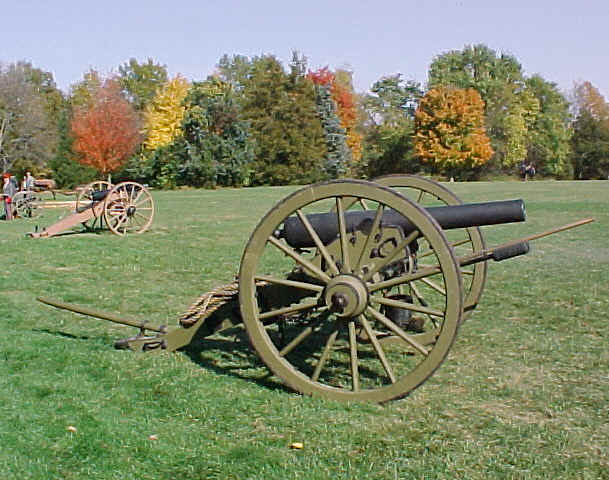Our Cannon
"The Senator"
![]()

![]()
The Cannon: 3 inch ordnance rifle manufactured Feb. 28, 1862 at Phoenix Iron Works. Serial number 315, weight 816 lbs. inspected by T.T.S.L. In the 20th. century the cannon was owned by the Army Corps of Engineers until sold in 1953 for scrap. The gun was restored in 1986 and all of the Iron is original. It can be seen in the following films: Glory (1989 ) and Gettysburg ( 1994 ). We have named the gun the Senator in honor of Art Stark who passed away in 1989 at the age of 78. Mr. Stark portrayed Tennessee Senator Gustavus Henry at re-enactment's.
( Photo taken in Princeton, IL. 10/10/1999. By Katy Goossens. )
![]()
Ordnance Board Tells How To Fire & Correctly Sponge.
Editor's Note: Peter A. Frandsen shares these Ordnance Board instructions for firing cannon with readers.
Ordnance Board, March 2d, 1841.
The accidental explosions of cannon, by which many lives and limbs are lost annually, are generally caused by fragments of burning cartridge from a previous discharge remaining in the gun, and which are not extinguished before the next charge is inserted. By observing the following directions, most of these accidents may be prevented.
1st. The powder should be contained in a cartridge bag, made of worsted stuff or serge, the material should be made of wool, of a close texture, and the bag should be sewed with woolen yarn.
2nd. The sponge should be made of woolen fringe, or sheep skin, with the wool outward, and it should fit the gun snugly, and fill the bore.
3rd. The finger stall is made of buckskin, or other soft leather, with a cushion stuffed with hair.
The vent (Torch Hole) should be stopped, by forcibly pressing the cushion upon it while the gun is being sponged and loaded. After the gun has been fired, it must be carefully sponged, to extinguish any burning remains of the cartridge. If this is carefully done with a dry sponge, it is certain to extinguish any pieces of burning flannel.
The sponge should be forced down firmly against the bottom of the bore, and in this position it should be turned round two or three times in each direction.
Care should be taken not to use a wet sponge. If it be slightly damped it may do no harm, but it is far safer to use the sponge dry than when it contains water, for the water is squeezed out and remains at the bottom of the bore. On inserting the next cartridge, it's lower end gets thoroughly soaked, and the wet powder does not burn on discharging the piece, but is driven into the pores of the woolen stuff, and forms a kind of match, which not only retains fire, but is with difficulty extinguished with the sponge, whereas, a dry piece of burning woolen is easily extinguished. The free use of water in sponging is the frequent cause of accidental explosions.
If the piece flash, or the priming tube blows, it should be approached carefully. The person who reprimes it should approach in front of the axletree, to avoid being injured by the recoil, incase the piece goes off from fire remaining in the vent.
None but careful, sober men, and well instructed should be allowed to sponge a gun or serve a vent.
The foregoing instructions have been prepared in ordnance to the directions of the Secretary of War of this date, and are respectfully submitted for this sanction.
BNEJ. HUGER
Captain and Secretary.
Approved: J.R. Poinset.
** Reprinted from the New York Military Magazine, Saturday, June 26, 1841, Volume 1, Number 3, page 47. Original copy supplied by Library, Special Collections, United States Military Academy via Peter A. Frandsen, The Artilleryman Bookshelf Editor.
Benjamin Hager (1805-1877) served on ordnance boards; co-wrote Instruction for Siege, Garrison, Coast and Mountain Artillery (1851); inspected cannon; and was Chief of Ordnance during the Mexican War with Gen. Winfield Scott, among other things.
According to artillery historian Wayne Stark, there survived today over 155 cannon inspected by Huger during years 1852 to 1861.
See Instruction for Field Artillery; M. C. Switlik, The More Complete Cannoneer; and "National Safety Rules and Procedures for Shooting Muzzle Loading Artillery" for more information on cannon safety.
![]()
"Last Updated... 08-27-2000"
Copyright © 1999 by Scott's Battery
If Interested in joining us or have questions or comments about our page,
Please feel free to e-mail us.